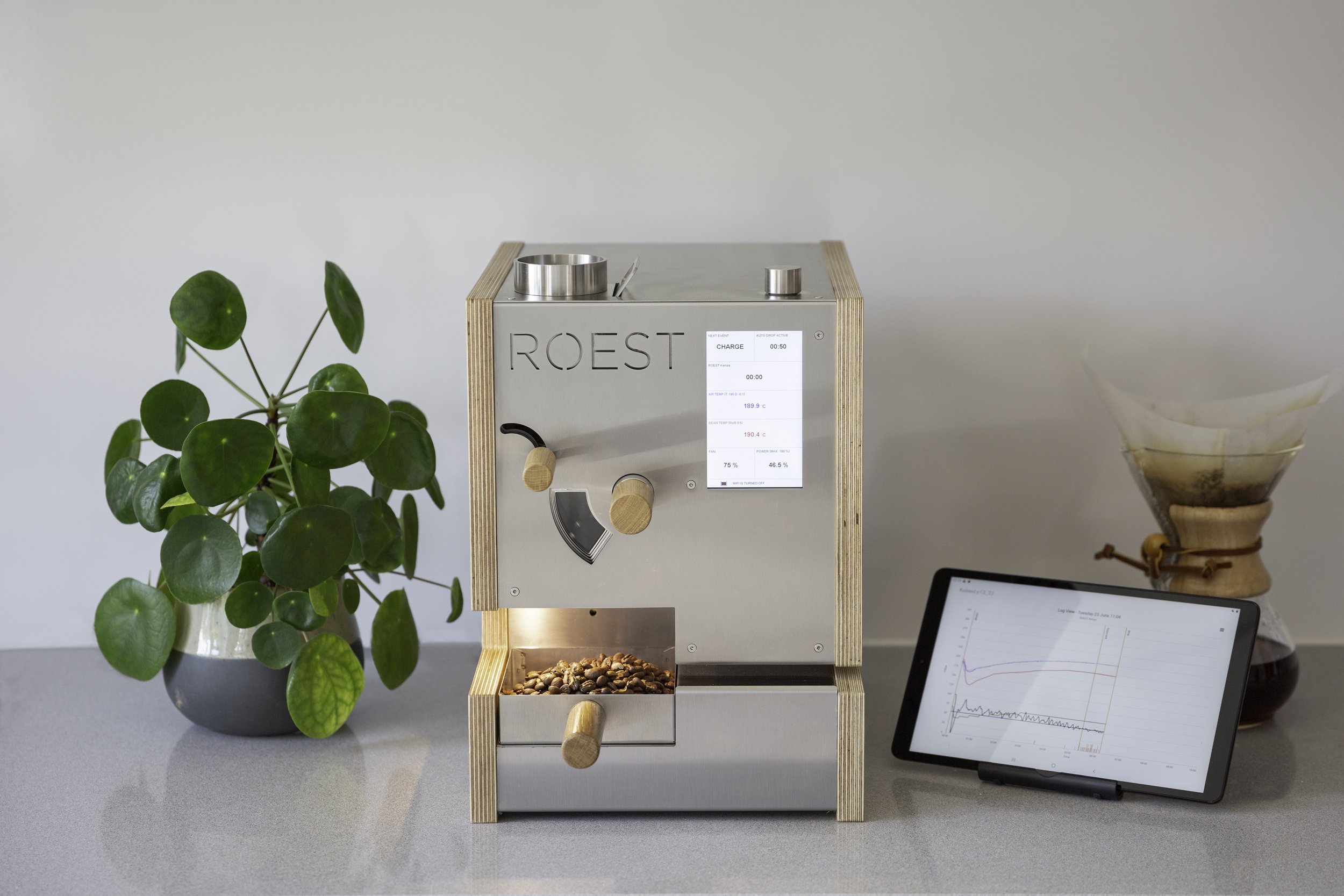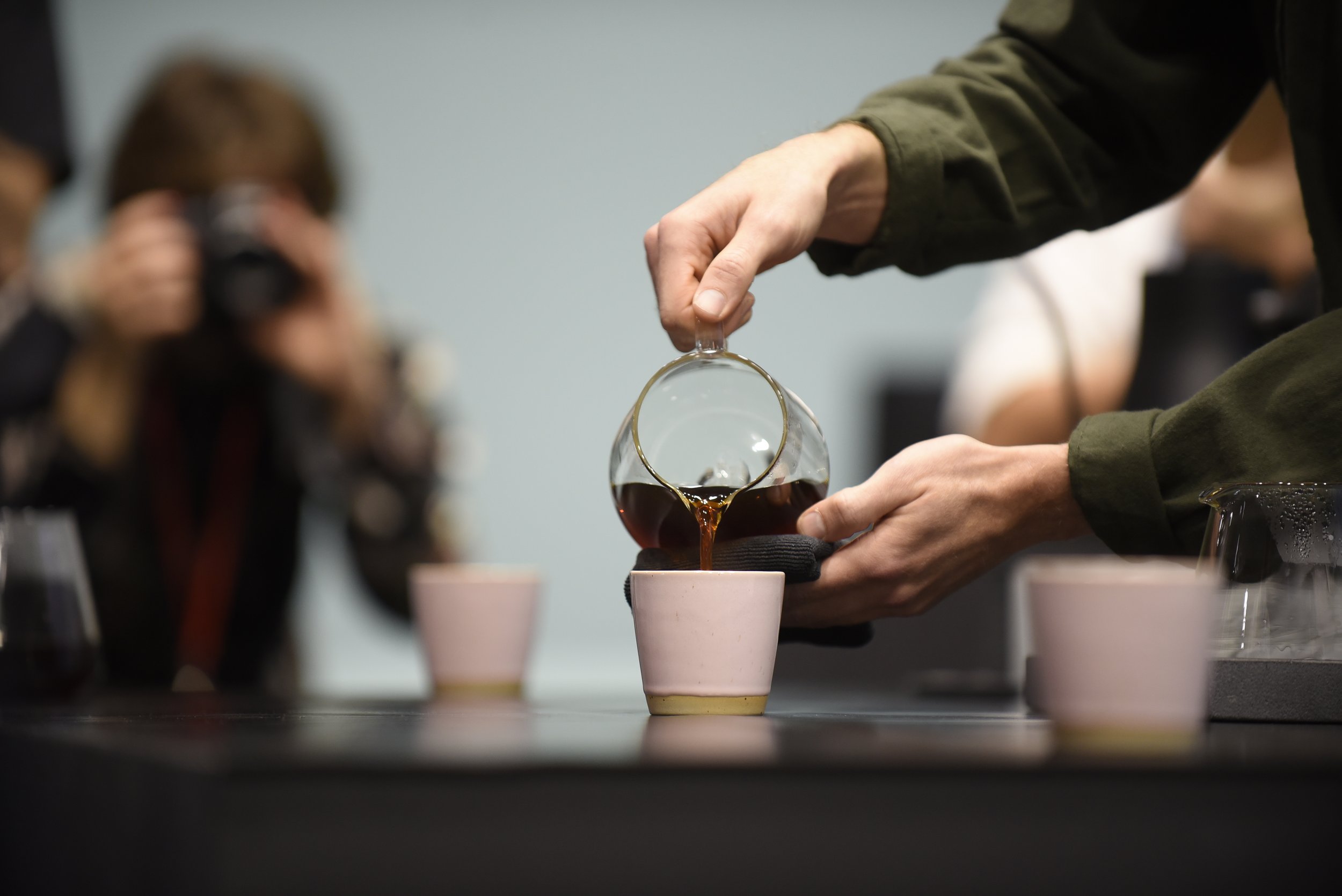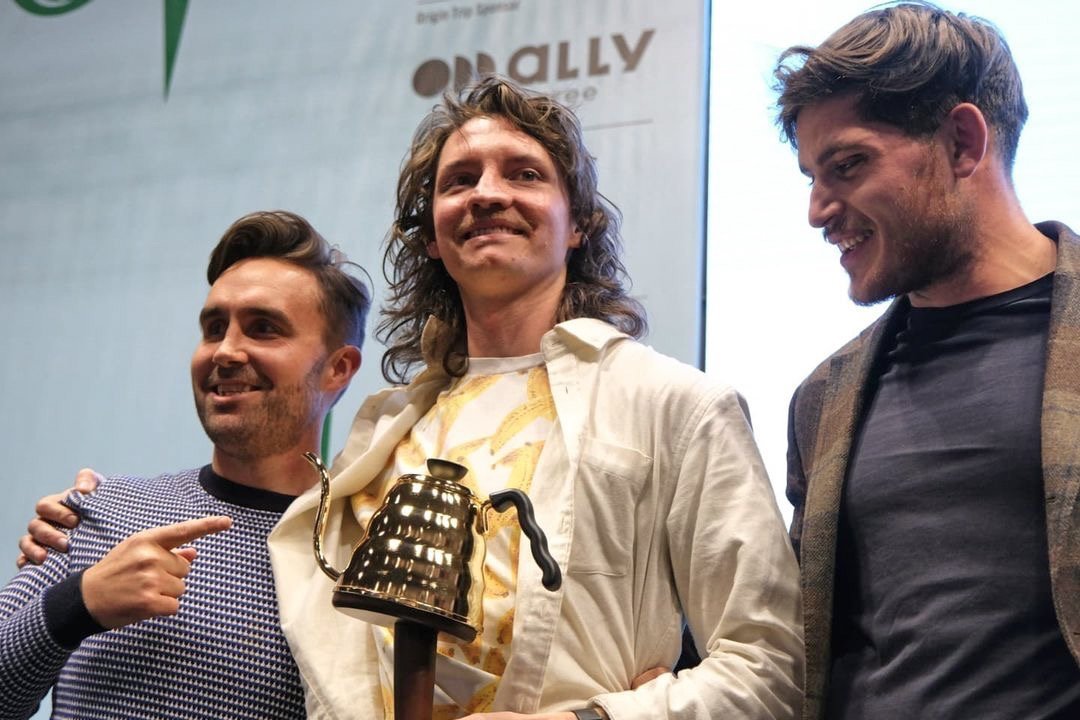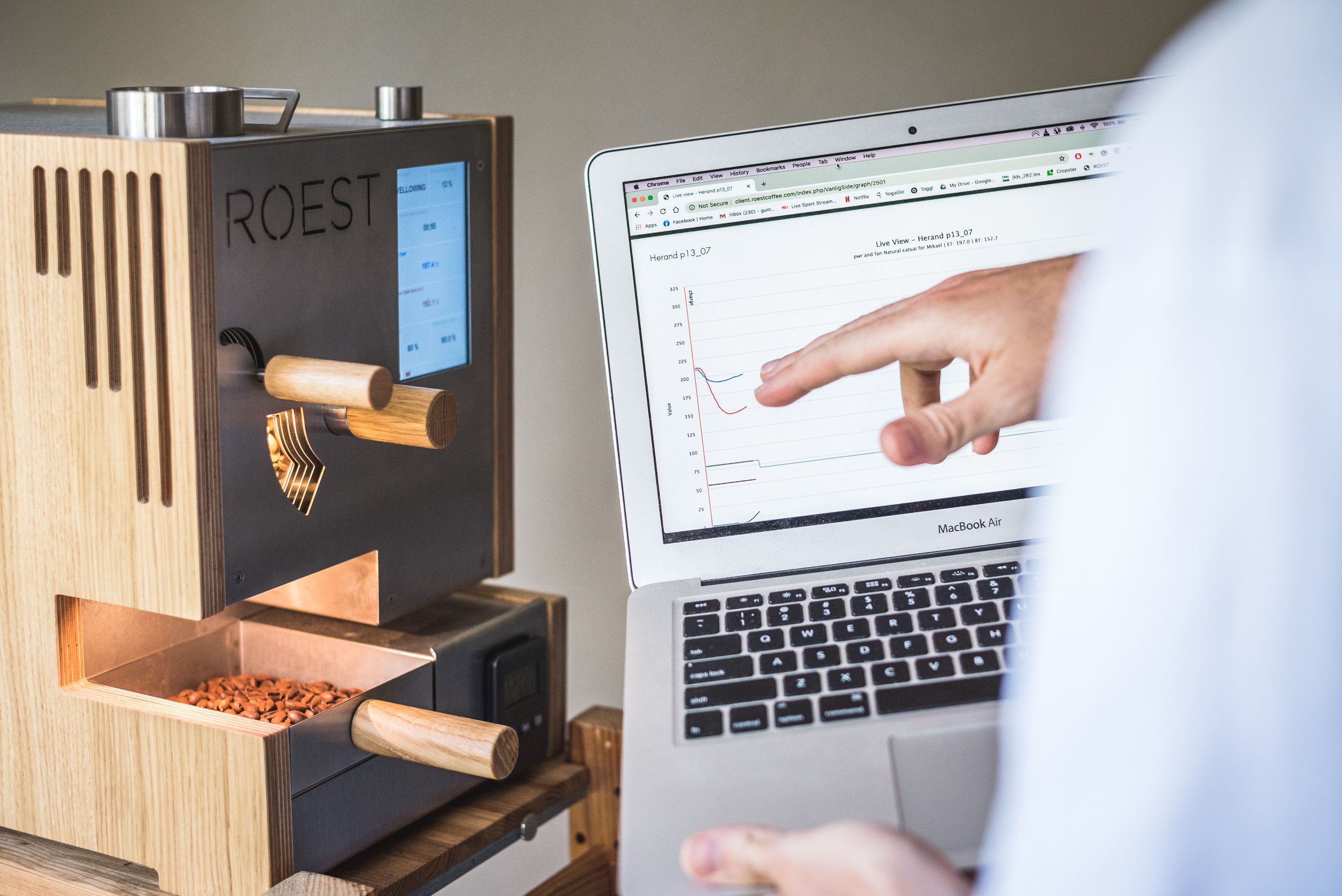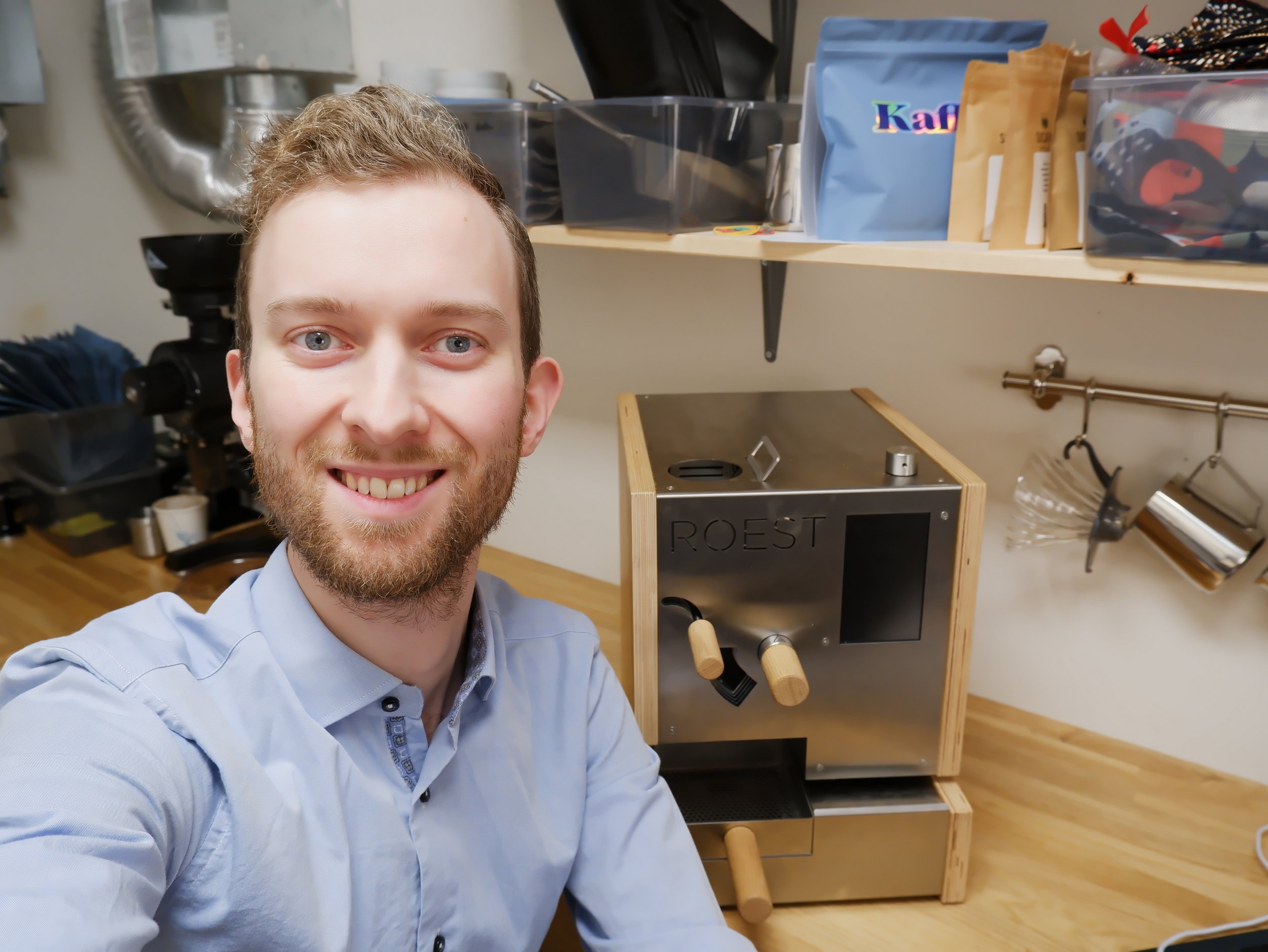
How Matt Winton prepared his winning coffee at the World Brewers Cup
Matt Winton earned the title of 2021 World Brewers Cup Champion with his exceptional blend of Catucai and Eugenioides. We spoke to Matt about his competition coffee: how it was prepared, the roasting process and blending, use of Eugenioides and the importance of water.
Matt Winton earned the title of 2021 World Brewers Cup Champion with his exceptional blend of Catucai and Eugenioides.
The Australian barista who now lives in Zurich, has previously won the Swiss Brewers Cup Championship and the Swedish Barista Championship - twice! After the World Stage in 2021, he could now add another title to the list.
After months of practice and preparations together with his team, they achieved a final blend that took the World Stage by storm. Their competition coffee consisted of a rare species called Eugenioides, which turned out to be a talking point of the show used by no less than three National Champions. This parent varietal of Arabica, noted for its intense sweetness and almost no perceived bitterness, was blended together with Catucai.
We spoke to Matt about his competition coffee: how it was prepared, the roasting process and blending, use of Eugenioides and the importance of water.
A wonderful performance and approach by Matt. Photo: Specialty PaL.
How did you start creating this coffee blend?
When I was looking at the blend, I looked at how each part of the blend fit in. I thought of it like in a musical way - we had the base which was this heavy body sweetness, not too much acidity, or in the Eugenioides’ case, no acidity, which provided the structure of the blend. Then we add on top whatever else was missing. Essentially, you could fill out the rest of the cup with the high notes - and that could be anything.
We chose the Catucai because it was so unique on its own. It has this strange herbal like taste of a very high quality. Reminding me of a verbena tea, rosemary or lemongrass. The cup was also really minty and had very light bright flavors. The acidities in that cup were next level - sparkling, vibrant and complex.
“The Eugenioides roasted with the ROEST ended up being mostly very fruity. We didn’t find that in some other roasters’ expressions of the coffee which is really interesting. ”
How was it like roasting these unique coffees?
Surprisingly, both of those coffees roasted really easily. We roasted the Catucai to have as much expressive acidity as possible. It was like - forget body in that coffee, just go for all of the high notes. We would roast the Catucai to have all of this top end of the brew, leaving the rest of that space to be filled by the Eugenioides.
We actually ended up using a few different roast profiles of Eugenioides to give different characters to the coffee, and some different lots of the Eugenioides as well. It wasn't as straightforward as just having Eugenioides and Catucai, but by blending different roast profiles - some that had more flavor intensity, some that had less flavor intensity and some that were more funky. It created this really complex synergy in the cup.
The Eugenioides roasted with the ROEST ended up being mostly very fruity. We didn't find that in some other roasters’ expressions of the coffee which is really interesting. So I guess it might also be the way that I roast, giving a lot of energy and then sort of letting it taper off quite quickly. It was very interesting to see the inherent taste differences roasted in a roaster.
The blend of Catucai and Eugenioides was roasted on the ROEST Sample Roaster.
Any tips on how to create a coffee blend? And how did you blend yours?
The amount of times where I've had exceptional blends, I just threw them together - a bit of this, bit of that, ground at the same setting, and brewed.
It's about throwing it together and seeing what happens. Surprisingly, I had to use more Eugenioides to make the Catucai shine. The sweetness of the Eugenioides got to carry the other flavors more. It's not always straightforward but more of a trial and error. It was a good learning experience for me.
Do you think we are going to see more Eugenioides on the World Stage from now on?
I’m sure we will. When the top three baristas use Eugenioides it sets a precedence that it's good. Even if you don't like it you have to value it, because it scored so highly. Personally, I don't like the taste of Eugenioides that much as a brew, but I think it's incredible to blend with. It can provide this amazing base - anything you add on top just shines. So it's really cool and almost any coffee works with it in a blend. You take anything you want - it just makes it better.
In action, first round of the WBrC. Photo: Specialty PaL.
Why is water so important in coffee? How can it influence the flavors or attributes?
Water is everything - it's 98.6% of this brew. If you haven't tried different waters like tap water, bottled water or filtered water - do it! You'll see there is a huge difference, especially if you have a bad tap water. Basically, the water itself can be huge in terms of the impact on not only the extraction, but the taste of the water.
The water that I had for the world stage was just yummy. It had this sweetness and crispy finish. We created six different waters in total. I brewed three V60s following the same recipes with a different water in each brew. The result was super interesting even though the differences in the minerals and concentration wasn't significant. We tested different types of magnesium, calcium and bicarb.
The other base water that we ended up using was the Lauretana water. It's a very low PPM water from Italy that sits at around 14 PPM. We tested it with the blend and the difference was huge. It was either a delicious cup or a disgusting cup.
Even on the day of the competition, we brewed the blend to see how it tastes and the water had “died”. It was just flat and I couldn't use it. So even the water being 24 hours old just didn't work. We had to re-make it that morning. It was really crazy.
Was it your best cup of coffee that you've ever had?
It's so hard to think about the best cup of coffee. It was probably the best cup of coffee I’ve ever served. All three of those cups on that finals day were the next level. It was like a jasmine syrup in the end, so sweet, floral - we'd never had these strong notes of jasmine before.
Yeah, it was probably the best cup of coffee I’ve ever served.
Matt Winton together with his teammates, Sam Corra and Tom Balerin. Photo: Specialty PaL.
A big thanks to Matt. Your experience and process inspires us! Well done and good luck on your next adventures - we’ll be rooting for you as always.
Read more about why he decided to roast his winning coffee on ROEST:
6 reasons why Matt Winton roasted on ROEST for the World Stage
Why exactly did Matt Winton choose to roast on ROEST for the World Stage? In this blog post, we will share his 6 reasons why and how ROEST can be of assistance in these competitions.
Roasting your own coffee for competitions can be a thrilling experience, and a perfect opportunity to develop and finesse your roasting skills. However, it is also an essential part to learn and understand inside out. You will need to create a perfect roast profile and deliver a consistent roast throughout the whole process.
Now, how can we make this process easier? Matt Winton’s solution was to acquire a ROEST Sample Roaster to stand by his side when preparing for competitions. Thereafter, Matt and his team created a beautiful blend with the help of ROEST that earned him the title of the 2021 World Brewers Cup Champion!
In this blog post, we will share the reasons why Matt decided to use ROEST for the World Stage. Exactly how can ROEST be of assistance in these competitions?
1. 100 grams - the perfect batch size
Prior to sample roasting, Matt’s experience mainly consisted of production roasting. In order to save time, costs and increase efficiency, he realized that he would need another solution for competitions, and decided to take a chance on the ROEST Sample Roaster. With a capacity of 50-120 grams, he would be able to make the most out of every single lot.
“When we're getting coffees for competition, it's not always the largest lots that we get. So it's nice to have the ability to roast smaller batch sizes. Around 100 grams is perfect, especially for Brewer's Cup, where we can get a good amount of brews per roast.” he says.
With ROEST he would also be able to reduce coffee waste. “It’s an optimum batch size that I've come to use, because most of the samples I get are around 100 or 200 grams. So then there's less waste, which is great.”
2. Simple transaction from gas burner to ROEST
Switching from one roaster to another may seem like a complicated process, but rest assured - it might not be as difficult as you think.
“I think coming from larger drum gas roasters where we had these variables of controlling your gas percentage, airflow, RPM, basically the way of thinking of the energy going in terms of a percentage, was similar to ROEST. I could convert it in my head sort of one-to-one,” he says. “I didn't need to overly think and come up with a whole new way of roasting just because I was using a different roaster.”
3. Straightforward - for both the novice and experienced
It took Matt about 2-3 months to completely understand and use ROEST to its full potential. “The learning curve was steep at the start, but then you just keep on learning. It's very intuitive,” he explains.
“It's straightforward. It's just so easy for me to make really tasty coffee. I don't consider myself the best roaster in the world. I think there's plenty of other people out there who have much more experience and understanding than I do, but I’m still able to get a really good result out of it.”
Whether you have roasting experience like Matt or are less experienced, ROEST is made easy and accessible for anyone despite previous skills. Thanks to smart technology, the passionate coffee novice can begin roasting automatically with Pre-set Profiles and First Crack Detection, and achieve a delicious cup of high quality coffee. And for the ones ready to explore manually - you are in for a treat with lots of variables to play around with!
4. Easy to bring, easy to set-up
Another perk of having a small-sized sample roaster? You can bring it wherever you want!
Matt can simply pack the Sample Roaster in the ROEST Peli Case and take it with him to his next competition or wherever else he’s flying off to. The padded interior features individual cut-outs for the Sample Roaster and equipment, keeping everything organized and safely stored the entire time he’s on the move.
“I'm able to bring it and set it up basically wherever I am - exhaust out the window, plug it in, connect online and just roast.” he says.
5. Consistency and repeatability
By using ROEST, Matt could ensure consistent, repeatable roasting. “The repeatability is really great and the speed is a lot faster than other roasters that I would have roasted with.” he tells us.
The ability to reliably reproduce the same flavor profiles is crucial in competitions. It can also be seen as a great challenge. Nevertheless, with ROEST’s digital precision, Matt could easily repeat the roast and avoid environmental variables and human error.
6. Features and sensors
ROEST makes it effortless to experiment by providing the ability to adjust different factors and manipulate the innate flavor locked within the green coffee.
“A machine like ROEST brings out a lot of variables to play with. In terms of having the green product, being able to give a roasted product, and then unlock them further through the brewing. We're able to tweak and see, for example, if I need to push the development a little bit further, a little bit less, bring out more brightness or want more body. With the ROEST, we're able to manipulate all of those factors.” he says.
Furthermore, all the adjustable parameters available on ROEST open up the opportunity to roast various types of coffees and obtain the desired flavor profile.
“I've got so many different types of coffees that I like to enjoy. Everything from mega fermenty naturally processed experimental lots all the way through classic clean coffees, some commodity coffee, some robusta, some everything - and I have the ability to roast everything how I want it.”
To sum up, Matt Winton decided to use ROEST due to its optimal batch size, straightforward roasting, various features and sensors, waste reduction, travel-friendliness and consistency.
Matt, thank you for taking time out of your busy schedule to have a chat. It’s been two great years working with you, and we look forward to another year together in 2022!
Adrian Berg's WBC journey
Adrian Berg, coffee roaster and two-time Norwegian Barista Champion, got the exciting opportunity to participate in the World Barista Championship 2021 (WBC). He was determined to roast his own competition coffee, and luckily for us, decided to use ROEST Sample Roaster on his WBC journey! We caught up with Adrian to find out how he prepared and built his final WBC-espresso profile with the help of ROEST.
Adrian Berg, coffee roaster and two-time Norwegian Barista Champion, got the exciting opportunity to participate in the World Barista Championship 2021 (WBC). He was determined to roast his own competition coffee, and luckily for us, decided to use ROEST Sample Roaster on his WBC journey!
We caught up with Adrian to find out how he prepared and built his final WBC-espresso profile with the help of ROEST:
Hello, my name is Adrian and I am the 2019 and 2020 Norwegian Barista Champion. I’ve been a competition barista for many years, but it was only after I started roasting my own coffee that I was able to win. For my 2020 WBC routine I knew I wanted to continue to roast the coffee myself, but I was also worried about committing large amounts of expensive coffee to trial roasting. So I reached out to ROEST who were super-kind to loan me one of their sample roasters.
Selecting Competition Coffee
My routine was built around the concept that flavour notes are not good enough tools when it comes to communicating flavour to customers. In order to make that point, I knew that I needed coffee with a lot of clarity that would be easy to describe so that I could deconstruct and explore how we can use flavour notes differently. Patrik Rolf at April Coffee Copenhagen helped me source my competition coffee and I ended up picking two: a gesha and an SL28 from Volcán Azul in Costa Rica, both anaerobic fermented and incredibly crisp and bright.
Trial Roasting
Having the ROEST available to trial roast the coffee was incredibly useful. I spoke with Matt Winton (who went on to win the World Brewers Cup!) about building a profile for espresso on the ROEST and after a lot of trial with a placeholder coffee I stumbled upon Wojtek Bialczak’s air temp profile on the ROEST community forum. I used that as my base profile to play around with the settings and find the right roast level.
Challenge of Espresso
“The biggest challenge with roasting for espresso on a sample roaster is that espresso generally needs to have higher solubility to work well, which requires longer roast times or a darker roast.”
Most profiles I found for the ROEST were anywhere from 4 to 6 minutes long, much too short for espresso. Using Wojtek’s air temp profile I was able to get roasts that were 8-9 minutes long. It started with a high charge temp, a short soaking period, then ramping the air temp back up before gradually bringing it down throughout the roast. This gave a very stable declining rate of rise and stretched the roast time beyond the six-minute mark.
(Development) Time is Key
The second challenge was finding the right development time. Most profiles I came across had a development time between 40 to 60 seconds. For an 8 minute roast 60 seconds is only a 12.5% development time ratio, which isn’t a lot for espresso. Since the air temp profile gave a steadily declining RoR the increase in bean temperature after first crack wasn’t that big either, so the coffee came out quite light with a very high and sharp acidity as espresso. The solution was to lower the air temperature after a little bit more from yellowing to increase the total roast time to 9 minutes and give the coffee a 90 second development time, increasing the DTR to 16%.
Saving Time with ROEST
If this all starts to sound a bit too technical, let’s just say it balanced out the coffee, made it more soluble and made a very nice espresso.
“For consistency I roasted several 100g batches back to back on the ROEST and blended them together to form a single batch. That was probably what I enjoyed the most about working with the ROEST.”
Once I was happy with the profile, recreating it was completely automatic with Auto First Crack Detection and playback of the profile. That freed up my hands and brain to continue working on my presentation and concept.
Want to know more about Adrian’s WBC process? Check out our latest video!
Reflections
I’m incredibly thankful to ROEST for the opportunity to work with their roaster. It helped me reach a final roast profile much quicker and with much less green coffee wastage, saving me time and money, both currencies that are incredibly valuable when preparing for a World Championship. I only took 25th place but I learned a lot from the experience. Seeing the passion, skill and dedication of the champions who went on to the semi-finals and finals was incredibly motivating. I look forward to the next time I’ll be in a coffee competition and continue to grow as a barista, roaster and person. Thank you, that’s my time!
Thank you, Adrian, for sharing your knowledge with the ROEST community. We are honored to have been a part of your WBC journey, and we’ll be rooting for you in all your future endeavors!
Text and photography by Adrian Berg
Want to know more about how ROEST can be used in competitions? Wojtek Bialczak participated in the World Barista Championship in 2019, and used ROEST sample roaster! He shared how it helped him and how it could help you:


